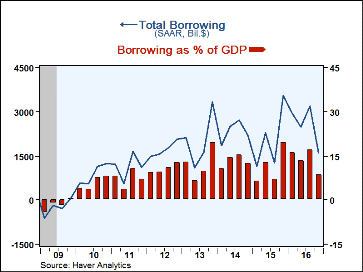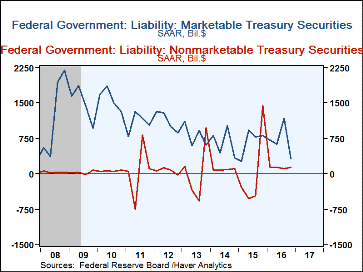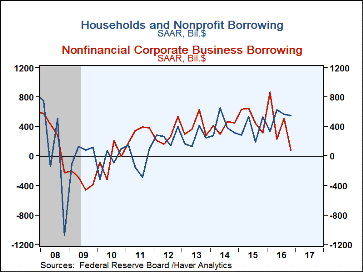 Global| Mar 09 2017
Global| Mar 09 2017U.S. Financial Accounts Show Moderation in Borrowing
Summary
The Federal Reserve's Financial Accounts data show less borrowing still in U.S. financial markets in Q4 2016. The total came to "just" $1,602 billion at a seasonally adjusted annual rate, about half the Q3 amount, $3,194 billion. The [...]
The Federal Reserve's Financial Accounts data show less borrowing still in U.S. financial markets in Q4 2016. The total came to "just" $1,602 billion at a seasonally adjusted annual rate, about half the Q3 amount, $3,194 billion. The Q4 amount represented 8.5% of GDP versus 17.1% in Q3. For all of 2016, borrowing totaled $2,553 billion, 13.8% of GDP, actually larger than in 2015, when it was $2,064 billion or 11.4% of GDP. A general range of 10-13% has prevailed since 2012, but that compares to the almost 29% average in the 5 years before the Great Recession and just under 20% over long stretches before then.
Federal government borrowing was $464 billion, SAAR, in Q4, much smaller than the $1,285 billion in Q3. Previous recent periods had run at about $700-800 billion, somewhere near the average of Q4 and Q3, so there may be timing issues in this recent pattern. Issuance of marketable Treasury securities was $327 billion in Q4, following Q3's $1,170 billion. Nonmarketable borrowing held to its recent pace, with $136 billion, up from $115 billion. In 2016 as a whole, federal government borrowing was $843 billion, moderately larger than 2015's $725 billion.
Two other major sectors had far smaller borrowing in Q4: nonfinancial corporate businesses used just $68 billion, SAAR, in net new credit, compared with $512 billion in Q3, and financial institutions borrowed just $56 billion after $540 billion in Q3. Nonfinancial corporate business paid down $70 billion worth of corporate bonds after borrowing $340 billion worth in Q3. They also paid down depository institution loans at a pace of $85 billion after net borrowing of $116 billion in Q3, and they borrowed smaller amounts in "other" loans and in mortgages. The one major credit type to increase was commercial paper, which rose at a $124 billion pace after paydowns of $139 billion in Q3. In all of 2016, nonfinancial corporations borrowed $420 billion, somewhat less than the $508 billion in 2015.
Financial institutions, as noted, used much less credit in Q4. They paid down loans and commercial paper as well as corporate bonds. Only the combined agency and GSE category experienced net borrowing.
Household borrowings, in contrast, held close to their Q3 pace in Q4, as they raised $554 billion, following $572 billion in Q3. Home mortgage borrowing increased modestly to $303 billion from $289 billion. Consumer credit usage fell somewhat, to $229 billion from $261 billion, including modest moves in credit card debt (larger), student loans (larger) and auto loans (smaller). During all of 2016, household debt rose $843 billion, up from $725 billion in 2015.
Household borrowing was 3.9% of disposable personal income in Q4, almost the same as the 4.0% in Q3. For the whole year, this ratio was 3.7%. As we have repeatedly pointed out in these summaries, this measure of debt burden is far smaller than in the run-up to the Great Recession: in 2003 through 2006, this ratio was just over 12%. So part of the reason the current expansion has been relatively slow is the restrained pace of borrowing after the excesses of that pre-recession period.
Press reports of these Financial Accounts highlight household balance sheets and net worth, and again describe the latest quarter-end amount, $92.8 trillion, as a "record." Indeed, household net worth did rise in Q4, by $2.0 trillion (quarterly rate, not seasonally adjusted). It reflects gains in several asset types, including homeowners' equity, direct holdings of corporate equities, pension entitlements and small business equity. Notably, some of these increases were smaller than in Q3 and, in fact, holdings of mutual fund shares declined absolutely during Q4. So moderation seems to pervade the household asset structure as well as liabilities.
Net wealth of the total economy moved ahead $2.0 trillion in Q4 to $84.8 trillion from $82.8 trillion at end-Q3 (also levels, not seasonally adjusted). The total market value of domestic corporations rose to $31.9 trillion from $30.6 trillion. Net financial claims on the "rest of the world" were again virtually unchanged at -$5.98 trillion versus -$5.83 trillion. The remainder of the net wealth measure consists of nonfinancial assets held by households, noncorporate business and governments; these totaled $58.9 trillion at end-Q3, up $800 billion from end-Q3.
The Financial Accounts data are in Haver's FFUNDS database. Associated information is compiled in the Integrated Macroeconomic Accounts produced jointly with the Bureau of Economic Analysis (BEA); these are carried in Haver's USNA database.
Carol Stone, CBE
AuthorMore in Author Profile »Carol Stone, CBE came to Haver Analytics in 2003 following more than 35 years as a financial market economist at major Wall Street financial institutions, most especially Merrill Lynch and Nomura Securities. She has broad experience in analysis and forecasting of flow-of-funds accounts, the federal budget and Federal Reserve operations. At Nomura Securites, among other duties, she developed various indicator forecasting tools and edited a daily global publication produced in London and New York for readers in Tokyo. At Haver Analytics, Carol is a member of the Research Department, aiding database managers with research and documentation efforts, as well as posting commentary on select economic reports. In addition, she conducts Ways-of-the-World, a blog on economic issues for an Episcopal-Church-affiliated website, The Geranium Farm. During her career, Carol served as an officer of the Money Marketeers and the Downtown Economists Club. She has a PhD from NYU's Stern School of Business. She lives in Brooklyn, New York, and has a weekend home on Long Island.









